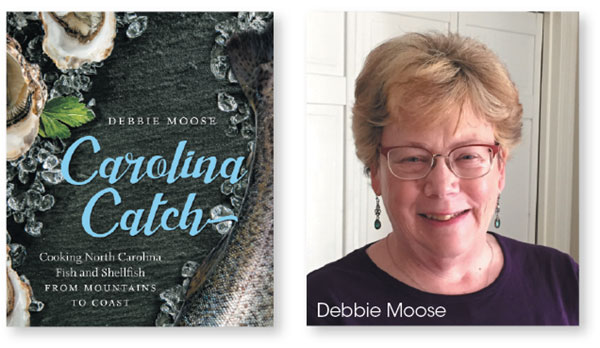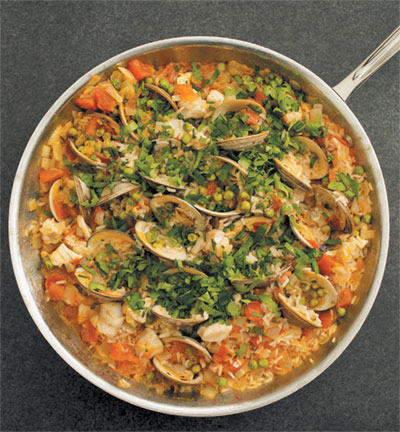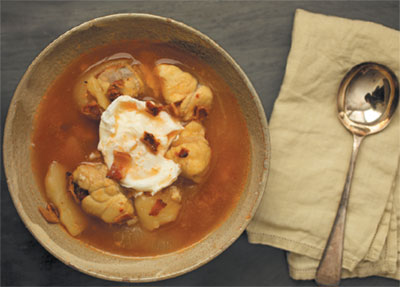 Triangle author's "Carolina Catch"
Triangle author's "Carolina Catch"
 When she was a kid, Debbie Moose ate her fair share of supermarket fish sticks. So, it was a whole other kettle of fish when she experienced the pure flavor of seafood in such East Coast specialties as raw oysters and fried soft-shell crab. In fact, it was love at first bite.
When she was a kid, Debbie Moose ate her fair share of supermarket fish sticks. So, it was a whole other kettle of fish when she experienced the pure flavor of seafood in such East Coast specialties as raw oysters and fried soft-shell crab. In fact, it was love at first bite.
The fishiest cookbook by Moose, a former food editor at The News and Observer in Raleigh, is "Carolina Catch: Cooking North Carolina Fish and Shellfish from Mountains to Coast." Her grilled tuna, steamed shrimp, pan-seared trout, fried catfish and baked littleneck clams – in fact, all 96 dishes – are sourced from the waters of the Tarheel State.
Moose is a reel expert and her book's off the hook. Here are three recipes from it.
 Smoked Trout Cheese Spread
Smoked Trout Cheese Spread
Smoked trout tastes milder than some smoked fish, which makes it a crowd pleaser. Briny capers and sharp red onions, along with a generous amount of black pepper, balance the rich cream cheese. The spread can be made up to 2 days before serving.
Alternative: smoked bluefish (stronger flavor)
Makes 10 to 12 servings
16 ounces cream cheese, at room temperature
2 tablespoons mayonnaise
3/4 cup coarsely chopped smoked trout
1/4 cup coarsely chopped red onion
Black pepper, to taste
2 tablespoons capers
1/2 cup chopped fresh parsley
Crackers for serving
Put the cream cheese, mayonnaise and smoked trout in the bowl of a food processor. Process until combined. Add the red onions, pepper and capers, and pulse a few times until they are just mixed in.
Scrape the mixture into a container and sprinkle with the parsley. Cover and refrigerate for at least 8 hours or overnight. Serve with crackers.
 Carolina Paella
Carolina Paella
Traditional Spanish paella includes mussels, shrimp, sausage and chicken. My simplified version speaks with a Carolina accent, spotlighting the state's abundant clams. I used an aromatic rice grown in South Carolina, but any medium-grain rice will do. Use a large, wide sauté pan or a paella pan, not a deep-sided frying pan.
Makes 4 Servings
1/2 cup olive oil
1 cup chopped white or yellow
onion
2 large tomatoes, chopped
3/4 teaspoon salt, divided
1 cup medium-grain rice
1 pound swordfish fillet, cut into
1-inch chunks
1/2 teaspoon crushed red pepper, or to taste
1 teaspoon paprika
1 cup fresh green peas
12 littleneck clams, rinsed well
1/4 cup chopped fresh parsley
2 tablespoons chopped fresh chives
Heat the olive oil in a large, wide sauté pan over medium heat. Add the onions, tomatoes and 1/4 teaspoon of the salt. Cook gently, stirring occasionally, for about 10 minutes or until the onions are soft and the tomatoes have given up their juices.
Add the rice, swordfish, crushed red pepper, paprika and 3 cups water, or enough to cover the ingredients (the amount will vary depending on how much liquid you get from the tomatoes). Season with the remaining salt. Add the peas. Place the clams in the mixture, gently nestling them into the liquid so that they are mostly covered.
Raise the heat and bring the mixture to a boil, then reduce the heat. Simmer, uncovered, for about 30 minutes or until the rice is cooked, the clams have opened and the liquid is gone. You can gently shake the pan to redistribute the ingredients, but do not stir the mixture during cooking. Gently move clams if necessary to keep them in the liquid. Sprinkle with the parsley and chives and serve.
Notes: Discard any clams that don't open after the cooking time. The crust that may form on the bottom of the paella, called "socarrat" in Spanish, is prized. If you smell a toasty but not burned aroma and feel a little gritty resistance when you poke the mixture gently with a spoon near the end of the cooking time, you have it. The "socarrat" adds a smoky note to the dish.
 Eastern North Carolina Fish Stew
Eastern North Carolina Fish Stew
in the Slow Cooker
Fish stew that includes poached eggs is an eastern North Carolina tradition, which cooks concoct from old recipe cards or simply from memory. After preparing it the usual way, by simmering on the stove, I thought it might work well in a slow cooker - and it did, with a few adjustments. Add the fish near the end of the cooking time to prevent overcooking. I poached the eggs separately, but if your slow cooker has a simmer function, you could try poaching the eggs in the broth, as is traditional.
Alternatives: drum, mahi, dogfish, sheepshead
Makes 6 servings
1-1/2 pounds potatoes, peeled and cut into 1/4-inch slices
1 large white or yellow onion, thinly sliced
4 medium cloves garlic, sliced
1-1/2 teaspoons salt
1/4 teaspoon crushed dried red pepper
2 tablespoons tomato paste
4 slices bacon
1-1/2 pounds monkfish fillets, cut into 6 pieces
6 eggs
Lightly spray the bottom of the slow cooker with nonstick cooking spray. Layer half of the potatoes, then half of the onions, half of the garlic, half of the salt and half of the red pepper. Repeat the layers with the remaining vegetables and seasonings.
Whisk the tomato paste into 2 cups of warm water until it dissolves, then pour over the layers. Add enough water to cover the layers, about 8 cups. Cover and cook on high for 3 hours.
Fry the bacon until crispy, drain and crumble. Reserve the bacon grease.
After 3 hours, pour 1 tablespoon of warm bacon grease into the stew, then nestle the fish gently into the liquid until completely covered. Cover and cook for 30 minutes to 1 hour or until the fish is flaky and cooked through. Thicker fillets will take more time than thinner fillets.
Poach the eggs in a pot of simmering water.
To serve, ladle the stew into bowls, including 1 piece of fish per serving, then add 1 poached egg. Top with crumbled bacon.
All recipes from "Carolina Catch: Cooking North Carolina Fish and Shellfish from Mountains to Coast." Text © 2018 by Debbie Moose. Food photography copyright © 2018 by Juli Leonard. Used by permission of the University of North Carolina Press. uncpress.org